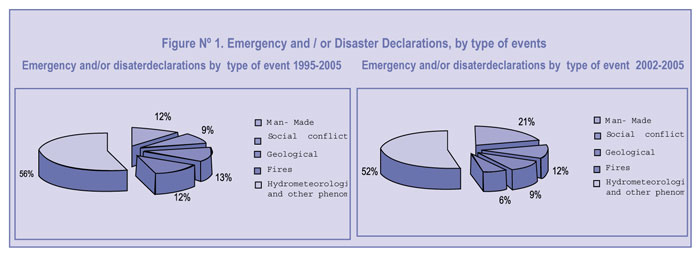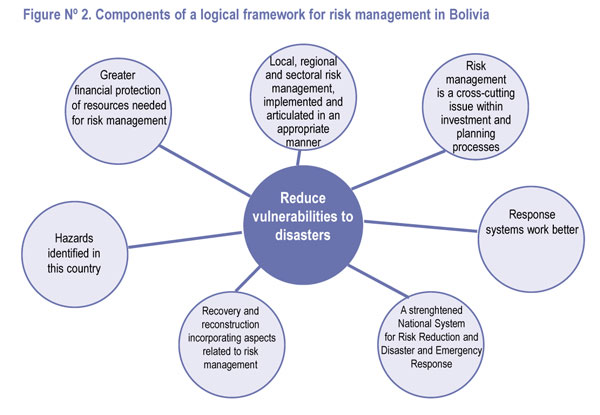| Bolivia: some lessons learned for the implementation of a risk management
approach
The
biologist Ludwig von Bertalanffy was the founder of the “General
Systems Theory” (GST). In his opinion, the GST should become both
a mechanism for integrating different natural and social sciences, and
a basic instrument for the training of scientists. In fact, social fabric,
State structures, administrative and budgetary management are all defined
and behave like systems. In most disciplines, we can also find the same
interpretation derived from the GST, and this includes Risk Management
(GR). For instance, many countries are already referring to Risk Management
Systems. Although we still do not completely understand the dynamics
of social systems and their economic, territorial and environmental components,
we are developing the conceptual foundation that will permit us to achieve
a better understanding. Along these lines, extensive experience has been
gained in Bolivia in the field of Risk Management. One example that illustrates
this is the Program for Disaster Prevention (IADB 1121/SF-BO), which
makes us reflect on some lessons learned during the last three years,
concerning the implementation of a risk management approach.
Taking into account the experiences acquired in other countries, the
conceptual foundation developed to date, as well as the interest caused
by the major disasters that have occurred during this decade, Bolivia
developed a modern legal framework over the course of three years, which
envisioned the establishment of government risk management policies.
Due to the creation of these mechanisms, it was deemed convenient to
design a process for implementing these legal instruments and the National
System for Risk Reduction and Disaster and Emergency Response (SISRADE),
though assistance offered by the Inter-American Development Bank (IADB)
in establishing policies and strengthening risk reduction activities.
In this framework, the Disaster Prevention Program (IADB1121) was created.
|
|
This program consists of two different components. The first one is
the strengthening of SISRADE through the planning of actions for risk
reduction and response strategies within the following sectors: health,
education, agriculture, public works and national defense. The second
component is the promotion of risk management. This project is being
funded under convenient and flexible financial terms during a three-year
period (non-extendable). The negotiation and approval processes were
relatively simple and fast because it was clear that the government of
Bolivia was committed to risk reduction, and because there was already
a legal framework in place.
Despite all this, the events that occurred afterwards would show that
there was a weak conceptual basis for this risk management approach,
as well as conflicts related to institutional competencies, lack of awareness
among decision makers and a limited capacity to link risk management
to the political and social agendas originated by existing social conflicts.
Description of the situation
The program was developed at the end of 2002. The Board of the IADB
approved it in December, 2003 and the contract was signed in June, 2004.
Operations and activities began in December 2005. During these three
years, the following events occurred:
- Due to existing
social conflicts and the deficient capacity of governments to build
consensus, between August 2003 and December 2005, the country
has had three different presidents. This situation has led to the
fast turnover of ministries and other public officials. For instance,
during
this period there were seven different ministers of sustainable development.
Thus, institutional systems and frameworks were greatly affected.
These changes in establishment also led to changes within the
State, due mostly to the passing of four different regulatory
laws that deeply
affected its organizational structure and responsibilities, as
they had been established by the legal framework of 2003. The contents
included
in these new legal standards represent a setback in the area of
risk
management, as well as a conflict between two institutions that
issued different interpretations, causing confusion at the moment
of applying
these new laws.
- During this
period, various initiatives from a number of international organizations
and NGOs were developed and led to the development of
national and sub-national projects. Due to the existing level
of confusion, these
initiatives have made it more difficult to reach an appropriate
level of coordination. This is reflected by the lack of coherence
between
most actions taken. This also has an impact on the efforts devoted
to establish
an integrated system that goes from the national to the municipal
levels and vice versa. Some of these initiatives are worth systematizing.
During this same period, a number of adverse events occurred,
exceeding the national capacity to adequately respond to
them (please see Figure
No. 1). As it may be observed, there exists an interesting ratio
between emergency responses and social conflicts (12% between 2002
and 2005).
This has created a bias in the interpretation and role of military
bodies within the SISRADE; the availability and use of financial
resources for
risk management, and the conceptual interpretation of a natural
or anthropogenic emergency or disaster, versus a social conflict
that put national security
at risk. The social problems that surfaced during this period have
generated a great deal of human suffering, with the actions
of
the government being
torn between controlling the public forces and providing and coordinating
humanitarian assistance. Actions implemented
Although this process grew to be complicated with a new change in government
in August 2003, initially, it had very important partners such as PREANDINO1
and the Risk Management Project in San Pedro River (PGRSAP), financed
by the GTZ. These partners provided assistance to and strengthened the
Ministry of Sustainable Development for the fulfillment of its main tasks.
Aware of these problems and the possibility of affecting existing credit
lines due to considerable delays in the implementation of this process,
the PGRSAP/GTZ and the IADB, in coordination with the ministries of sustainable
development and national defense, promoted actions that supported the
continuity of the IADB 1121 project. These actions were taken under the
following principles:
- Reach agreements.
Create spaces for dialogue between the ministries of sustainable
development and national defense. Through letters and
other means, agreements were reached in support of the implementation
of this program.
- Build capacities.
Establish a standard conceptual foundation through a capacity-building
process intended for public officials, with the assistance
of the UNDP.
- Develop and
assess a logical framework. Carry out a rapid assessment of the current
situation involving the management of existing hydrometeorological,
seismic and volcanic hazards, as well as regarding vulnerability
analyses,
impact assessments, and preparedness and response plans. Based on
this study, a logical framework for risk management was developed
in Bolivia,
through a participatory process with all institutions that compose
the SISRADE (please see Figure No. 2).
- Creation of
a coordinating unit. With the valuable support of PGRSAP/GTZ, a number
of activities of the Program Coordinating Unit (UCP) were carried
out to promote spaces for consensus building, in order to meet the
requirements
established for the program's eligibility and provide technical assistance
to the beneficiary ministries.
- Organization
of a coordinating platform. Due to the need to create a logical framework
for risk reduction in Bolivia, a space entitled Forum
of Cooperating Bodies for Risk Management and Sustainable Development
was created to coordinate efforts with NGOs and international development
agencies. The aim of this forum was to improve the existing capacity
to coordinate efforts and create synergies between programs and projects
that include integrated actions, through the UCP, the IADB 1121 Program
and all stakeholders involved.
Some lessons learned
The following lessons were learned throughout this process:
- The implementation
of a systemic approach for risk management is an ongoing process
based upon the existing socioeconomic conditions and policies in
each country,
as well as the capacities and processes established within other
consolidated systems. In other words, it is important to foresee
the potential effects
of risks and disasters on sectoral development strategies, showing
the importance of incorporating them in a comprehensive manner
and beyond the establishment of isolated risk management policies
and plans.
- Concerning
the reduction of existing vulnerabilities and the creation of monitoring
systems for disaster response, it is necessary to put into context
and prioritize all State actions. It is also important to define risk indicators
within this process, so that short, mid and long-term measurable goals
are established, based upon their cost-benefit ratio. This would
show the
level of effectiveness
of those prevention and mitigation actions undertaken. It is also important
to show, through appropriate indicators, the effectiveness and
efficiency of resource
management and coordination activities in emergency or disaster situations.
- The development
of this type of system must be promoted gradually by fostering
the strengthening of existing coordination mechanisms and by analyzing
decentralization processes. This will lead to the promotion of appropriate
vertical and horizontal integration, based upon the participation of civil
society in
decision-making processes.
- It is important
to continue developing processes for capacity building in the area
of risk and disaster reduction. This will lead to the creation
of research mechanisms that collectively will expand existing learning
capacities and knowledge development. In this manner, a conceptual
foundation will
be developed
in order to adapt this system to national and cultural conditions.
- It is also
important to continue developing dissemination activities and programs
for raising awareness among the population at risk, based
on existing capacities for communicating and developing a type of knowledge
able to adapt
to its environment. This will lead to the creation of new habits
and customs toward the reduction of existing vulnerabilities.
- Finally,
it is imperative to establish units, platforms or mechanisms that
favor the exchange of information, in order to foster coordination
at sectoral and sub-national levels. This will lead to the establishment
of clear responsibilities
and the inclusion of other actors, such as aid agencies, NGOs and
the
private sector.
Although this account has not yet come to an end, it is expected that
the IADB 1121 Program will continue to foster the creation of coordination
channels and opportunities for different stakeholders, departments, municipalities
and other programs related to risk management to receive technical assistance,
with the common purpose of reducing the existing levels of vulnerability
in Bolivia.
For additional information, please contact:
Marco Antonio Rodríguez
Consultant, risk management
marqor@yahoo.com
|






